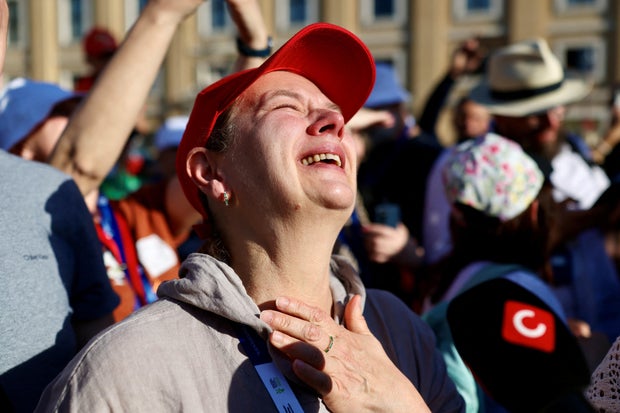White smoke has emerged from the chimney above the Sistine Chapel at the Vatican, signaling that a new pope has been chosen with a decisive vote by the cardinal electors gathered for the papal conclave. Soon, the crowd in St. Peter’s Square and people around the globe will hear the traditional proclamation, “Habemus papam” — Latin for “We have a pope” — and learn who has been chosen as the 267th pontiff to lead the world’s 1.4 billion Catholics.
Tens of thousands of people gathered in the late afternoon sunshine in St. Peter’s Square at the Vatican erupted in a cheer as the smoke was seen pouring from the chimney.
Dylan Martinez/REUTERS
When will we know who the new pope is?
It has historically taken a little time for the Vatican to announce the name of the new pope after the white smoke is seen above the Sistine Chapel.
In 2013, when Pope Francis was elected, it took around an hour for his identity to be made public.
After a pope is elected by the cardinal electors, he is asked whether he accepts the results of the vote and what name he chooses to go by as pontiff. Once he formally accepts the role and chooses his name, cardinals then express their homage and obedience to the new leader of the Catholic Church, and he is fitted with his papal robes.
Traditionally, an announcement is then made from the balcony of St. Peter’s Basilica. Then the new pontiff steps out onto the balcony and makes his first public appearance to deliver a blessing.
Kevin Coombs/REUTERS
The cardinals responsible for choosing a new pope typically select someone from among their own ranks, although it isn’t required. This time around, Vatican-watchers have focused on about a dozen cardinals viewed as potential frontrunners. But the closed-door decision-making can go in surprising ways as the cardinal electors wrestle with the challenges facing the church and different visions for its future.
How does the duration of the 2025 conclave compare to past conclaves?
The conclave to choose a successor to Pope Francis began on Wednesday afternoon, local time. The 133 cardinal electors taking part in the process prayed together and took a vow of secrecy before the doors closed and the first round of votes were cast. As night fell, black smoke rose from the Sistine Chapel’s chimney, indicating they had not yet agreed on a choice.
On Thursday morning, the cardinals resumed the process for Day 2 and, yet again, before lunch time in Rome, black smoke signaled no decisive outcome from the morning’s round of two votes.
In recent history, conclaves have tended to only last a couple of days, and this year’s followed suit.
Some past conclaves, however, dragged on much longer. The longest one ever, in the 13th century, took almost three years to choose Pope Gregory X.
The shortest conclave on record, in 1503, took just 10 hours to choose Pope Pius III.
How long was the conclave that elected Pope Francis?
The conclave that elected Pope Francis began on March 12, 2013, and he was announced as pope the next day, after five ballots.
The conclave that elected his predecessor, Pope Benedict XVI, began on April 18, 2005. Benedict was announced as pope the next day after four ballots.
This is a developing story and will be updated.

